Topics 2010
December 2010
Dec. 28, 2010 Updated
Many thanks! Farewell greetings from JAXA i
|
The JAXA information center, JAXA i, which worked as a connecting point between people and "the sky and space" in Marunouchi, Tokyo, closed permanently on Dec. 28 (Tue.) We've been providing various information on the sky and space through events including a monthly talk show, and a live launch broadcast, and we now feel that the most precious treasure we have gained from JAXA i is the ties born between you and JAXA. We would like to consider your heartfelt support as a star of hope to strive for further development of aerospace activities. JAXA i has completed its almost six-year history, but your continued support will be very much appreciated. |
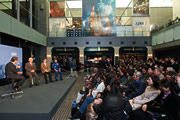
|
|---|
December 21, 2010 Updated
Information Center JAXA i Special Closing Events
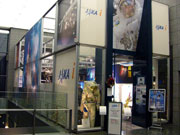 JAXA's information center, JAXA i, which has been dispatching various information on Japan's and JAXA's aerospace activities and has been loved by many aerospace fans, will be closing down permanently on Dec. 28 (Tue.) To express our appreciation to all of you, we would like to hold some special closing events. We plan to have talk shows where JAXA personnel will reflect upon JAXA activities in 2010 and express their enthusiasm for the future, and have a live broadcast of "space education TV."
JAXA's information center, JAXA i, which has been dispatching various information on Japan's and JAXA's aerospace activities and has been loved by many aerospace fans, will be closing down permanently on Dec. 28 (Tue.) To express our appreciation to all of you, we would like to hold some special closing events. We plan to have talk shows where JAXA personnel will reflect upon JAXA activities in 2010 and express their enthusiasm for the future, and have a live broadcast of "space education TV."
These are the very last events at JAXA i, so we are looking forward to seeing as many of you as possible.
Events:
- KOUNOTORI (HTV) Festival
Time and date: 1:00 - 6:00 p.m. on Dec. 23 (Thu. Holiday) - JAXA i Monthly Talk
Time and date: 3:00 - 4:00 p.m. on Dec. 24 (Fri.) - Space Education TV / Internet Live Broadcast
Time and date: 2:00 - 3:30 p.m. on Dec. 28 (Tue.) - Closing Special Talk Session
Time and date: 6:30 - 7:30 p.m. on Dec. 28 (Tue.) - Closing Greetings
Time and date: 8:00 p.m. on Dec. 28 (Tue.)
December 10, 2010 Updated
AKATSUKI takes images of Venus during functional verification
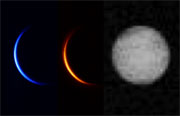 JAXA is currently investigating the failure cause of the Venus orbit injection of the Venus Climate Orbiter “AKATSUKI.” During the course of the orbiter functional verification after data acquisition at the periVenus, we were able to obtain some Venus images captured by the AKATSUKI at around 9:00 a.m. on Dec. 9 (Japan Standard Time.)
JAXA is currently investigating the failure cause of the Venus orbit injection of the Venus Climate Orbiter “AKATSUKI.” During the course of the orbiter functional verification after data acquisition at the periVenus, we were able to obtain some Venus images captured by the AKATSUKI at around 9:00 a.m. on Dec. 9 (Japan Standard Time.)
(Images: from left, an image shot by the UVI, IR1, and LIR. The images are artificially colored: The UVI image with blue, and the IR1 image with orange.)
December 8, 2010 Updated
AKATSUKI Venus orbit injection plan to be reviewed
JAXA found that we have failed to inject the Venus Climate Orbiter “AKATSUKI” into the planned Venus orbit after conducting the Venus orbit insertion maneuver (VOI-1) on December 7. While we set up a new investigation team to study the cause and countermeasures, we will also review the Venus orbit injection plan again to take the next opportunity in six years when the AKATSUKI flies closest to Venus.
December 8, 2010 Updated
AKATSUKI Venus observation orbit injection result
JAXA conducted the Venus orbit insertion maneuver (VOI-1) for the Venus Climate Orbiter “AKATSUKI” at 8:49 a.m. on December 7 (Japan Standard Time,) but, unfortunately, we have found that the orbiter was not injected into the planned orbit as a result of orbit estimation. The “AKATSUKI” was launched from the Tanegashima Space Center on May 21. JAXA has set up an investigation team to study the cause of the failure. We will update you with the investigation results and AKATSUKI operation status on the web.
December 3, 2010 Updated
Please support AKATSUKI as it enters the Venus Orbit on Dec. 7
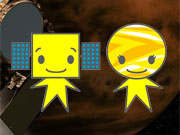 The Venus Climate Orbiter "AKATSUKI" will finally be injected into its Venus orbit on December 7. We are planning some events to support the AKATSUKI project on that day including the "Venus arrival live broadcast" featuring the AKATSUKI project, a public viewing to show the AKATSUKI control room at the time of orbit insertion, and an observation event of Venus with pundits. Your support will be very much appreciated!
The Venus Climate Orbiter "AKATSUKI" will finally be injected into its Venus orbit on December 7. We are planning some events to support the AKATSUKI project on that day including the "Venus arrival live broadcast" featuring the AKATSUKI project, a public viewing to show the AKATSUKI control room at the time of orbit insertion, and an observation event of Venus with pundits. Your support will be very much appreciated!
November 2010
November 18, 2010 Updated
Date of AKATSUKI injection to Venus orbit
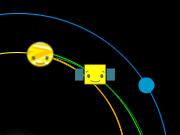 JAXA decided to emit jets from the orbital maneuvering engine (OME) of the AKATSUKI at 8:49:00 a.m. on Dec. 7 (Japan Standard Time, all the following dates and time are in JST) to inject the orbiter into the Venus orbit. Under the current schedule, the OME jet emission will be completed at 9:01:00 a.m. on the same day, and the Venus orbit will be determined around 9:00 p.m. also on the same day after some attitude control maneuvers including the Earth pointing maneuver of the Z axis.
JAXA decided to emit jets from the orbital maneuvering engine (OME) of the AKATSUKI at 8:49:00 a.m. on Dec. 7 (Japan Standard Time, all the following dates and time are in JST) to inject the orbiter into the Venus orbit. Under the current schedule, the OME jet emission will be completed at 9:01:00 a.m. on the same day, and the Venus orbit will be determined around 9:00 p.m. also on the same day after some attitude control maneuvers including the Earth pointing maneuver of the Z axis.
The AKATSUKI will study the Venus atmosphere for about two years after being injected into the Venus orbit.
November 16, 2010 Updated
Particles brought back by Hayabusa identified as from Itokawa
JAXA has been engaged in collecting and categorizing particles in the sampler container that were brought back by the asteroid explorer "HAYABUSA."
As a result of the scanning electron microscope (SEM) observations and analyses of the samples, about 1,500 grains were identified as rocky particles, and most of them were judged to be of extraterrestrial origin, and definitely from Asteroid Itokawa, after further study of the analysis results and comparison of mineral compositions.
Their size is mostly less than 10 micrometers, and handling these grains requires very special skills and techniques. JAXA is developing the necessary handling techniques and preparing the associated equipment for the initial (but more detailed) analyses of these ultra-minute particles.
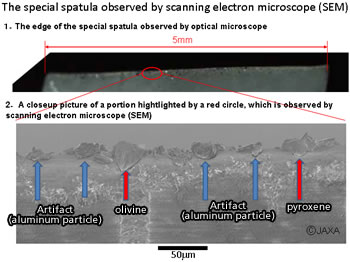
November 11, 2010 Updated
HTV nickname selected & special site open!
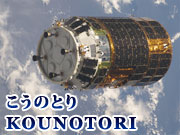 "KOUNOTORI" (meaning "a white stork" in English) was chosen as the nickname of the H-II Transfer Vehicle (HTV, a cargo transfer vehicle to the International Space Station.)
"KOUNOTORI" (meaning "a white stork" in English) was chosen as the nickname of the H-II Transfer Vehicle (HTV, a cargo transfer vehicle to the International Space Station.)
During a month-long nickname campaign, we received 17,236 suggestions.
Among them, "KOUNOTORI" was selected because a white stork carries an image of conveying an important thing (a baby, happiness, and other joyful things); therefore, it precisely expresses the mission to transport essential materials to the ISS.
The KOUNOTORI2 is scheduled to be launched by the H-IIB Launch Vehicle No. 2 (H-IIB F2) at around 3:29 p.m. (Japan Standard Time) on January 20 (Thu.), 2011.
Taking this opportunity of selecting the nickname, we would also like to open the "KOUNOTORI2/H-IIB F2 Special Site." We will provide you with updated information about the project including a column by project personnel and launch related matters. Please enjoy the site!
* Launch time will be determined by the updated orbit of the ISS.
November 10, 2010 Updated
Launch day set for HTV2/H-IIB F2!
 The launch date and time for the H-IIB Launch Vehicle No. 2 (H-IIB F2) with the H-II Transfer Vehicle (HTV2) onboard was set for around 3:29 p.m. on January 20 (Thu.), 2011 (Japan Standard Time). The HTV2 is a cargo transporter to the International Space Station (ISS.) The integration of all modules of the HTV2 was completed at the Tanegashima Space Center (TNSC), and it will enter the final launch preparation phase. The H-IIB F2 has already been transported to the TNSC, and it is now being assembled there.
The launch date and time for the H-IIB Launch Vehicle No. 2 (H-IIB F2) with the H-II Transfer Vehicle (HTV2) onboard was set for around 3:29 p.m. on January 20 (Thu.), 2011 (Japan Standard Time). The HTV2 is a cargo transporter to the International Space Station (ISS.) The integration of all modules of the HTV2 was completed at the Tanegashima Space Center (TNSC), and it will enter the final launch preparation phase. The H-IIB F2 has already been transported to the TNSC, and it is now being assembled there.
* Launch time will be determined by the updated orbit of the ISS.
November 2, 2010 Updated
10th anniversary of continuous human presence at ISS
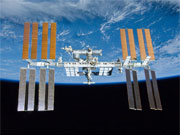 November 2, 2010, marks the 10th anniversary since the first astronaut began to stay at the International Space Station (ISS). At 6:21 a.m. (JST) on Nov. 2, 2000, the first expedition crew consisting of two Russian cosmonauts and one American astronaut aboard the Soyuz spacecraft successfully docked with the ISS. They stayed there for about four months.
November 2, 2010, marks the 10th anniversary since the first astronaut began to stay at the International Space Station (ISS). At 6:21 a.m. (JST) on Nov. 2, 2000, the first expedition crew consisting of two Russian cosmonauts and one American astronaut aboard the Soyuz spacecraft successfully docked with the ISS. They stayed there for about four months.
In this decade, five Japanese astronauts have stayed at the ISS (of which two were there as members of the expedition crew) to complete the Japanese Experiment Module "Kibo." Astronaut Satoshi Furukawa is scheduled to stay there for a prolonged period in 2011, followed by Astronaut Akihiko Hoshide in 2012.
October 2010
October 26, 2010 Updated
MICHIBIKI begins transmitting all positioning signals, ground stations confirm them
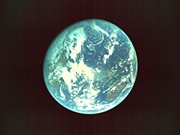 Following the transmission of the L1-SAIF signal from the L1-SAIF antenna aboard the Quasi-zenith Satellite "MICHIBIKI" on October 19, the other positioning signals (L1-C/A, L2C, L5, L1C, and LEX) were also transmitted from the MICHIBIKI’s L-band Helical antenna. While we were confirming that there was no interference with conventional satellite positioning services including the GPS service, we gradually increased the output power of the signals.
Following the transmission of the L1-SAIF signal from the L1-SAIF antenna aboard the Quasi-zenith Satellite "MICHIBIKI" on October 19, the other positioning signals (L1-C/A, L2C, L5, L1C, and LEX) were also transmitted from the MICHIBIKI’s L-band Helical antenna. While we were confirming that there was no interference with conventional satellite positioning services including the GPS service, we gradually increased the output power of the signals.
On October 26, we started transmitting the signals with their nominal full power, and confirmed that the ground system properly received them.
We will continue conducting the initial functional verification of the onboard devices (for abut three months after launch) in cooperation with organizations that are in charge of technical verification.
(Image: Earth image taken by MICHIBIKI onboard monitor camera at noon on Oct. 26 (JST))
October 18, 2010 Updated
Agreement on wetland survey by DAICHI with Ramsar Convention Secretariat
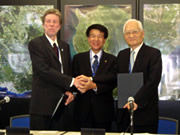 On October 18, JAXA and the Ramsar Convention Secretariat participated in the 10th Conference of the Parties (COP 10) to the Convention on Biological Diversity entitled "The role of the Ramsar Convention in the implementation of the Convention on Biological Diversity," and agreed to cooperate in a global survey of the Wetlands of International Importance through the use of the Advanced Land Observing Satellite "DAICHI." We have since signed the cooperation agreement.
On October 18, JAXA and the Ramsar Convention Secretariat participated in the 10th Conference of the Parties (COP 10) to the Convention on Biological Diversity entitled "The role of the Ramsar Convention in the implementation of the Convention on Biological Diversity," and agreed to cooperate in a global survey of the Wetlands of International Importance through the use of the Advanced Land Observing Satellite "DAICHI." We have since signed the cooperation agreement.
Although wetlands are extremely important for flora and fauna, many wetlands are under the threat of disappearance in the world. Data from the DAICHI can contribute to the appropriate maintenance of those wetlands all over the world as it can continuously monitor flora and fauna.
After signing the agreement, images captured by the DAICHI will be published as a database to be useful for evaluating and maintaining wetlands as well as for compiling a wetland list.
October 12, 2010 Updated
-Space Day Open-house-
Enjoy a space experience at the Tsukuba Space Center
 To commemorate Space Day, JAXA will hold its annual autumn open-house evet at our facilities. On Oct. 16 (Sat.), we will have a special open-house event at the Tsukuuba Space Center under the catchphrase: “Let’s go and try an authentic space experience.” We are preparing various events including a live lecture by Astronaut Furukawa from Houston, a plastic bottle rocket class, and a space experiment show. On Oct. 24 (Sun.), the Masuda Tracking and Communication Station will also hold an open-house. Please visit our facilities on this occasion.
To commemorate Space Day, JAXA will hold its annual autumn open-house evet at our facilities. On Oct. 16 (Sat.), we will have a special open-house event at the Tsukuuba Space Center under the catchphrase: “Let’s go and try an authentic space experience.” We are preparing various events including a live lecture by Astronaut Furukawa from Houston, a plastic bottle rocket class, and a space experiment show. On Oct. 24 (Sun.), the Masuda Tracking and Communication Station will also hold an open-house. Please visit our facilities on this occasion.
September 2010
September 27, 2010 Updated
MICHIBIKI injected into the quasi-zenith orbit with its center longitude of about 135 degrees
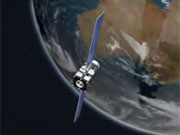 The First Quasi-Zenith Satellite MICHIBIKI, which was launched by the H-IIA Launch Vehicle No. 18 on Sept. 11 (JST,) has been maneuvered to shift its orbit from the drift orbit to the quasi-zenith orbit starting on the 21st. The satellite is now confirmed to be inserted into the quasi-zenith orbit over Japan with its center longitude of about 135 degrees through the final orbit control performed at 6:28 a.m. on Sept. 27.
The First Quasi-Zenith Satellite MICHIBIKI, which was launched by the H-IIA Launch Vehicle No. 18 on Sept. 11 (JST,) has been maneuvered to shift its orbit from the drift orbit to the quasi-zenith orbit starting on the 21st. The satellite is now confirmed to be inserted into the quasi-zenith orbit over Japan with its center longitude of about 135 degrees through the final orbit control performed at 6:28 a.m. on Sept. 27.
We will carry out initial functional verification of the satellite including the onboard devices for about three months in cooperation with organizations for technological verifications.
September 19, 2010 Updated
MICHIBIKI shifted to the regular control mode
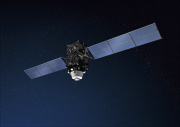 The first quasi-zenith satellite MICHIBIKI, which was launched by the H-IIA Launch Vehicle No. 18 on September 11, was injected into its drift orbit (or the orbit that is one step before getting into the quasi-zenith satellite) after five apogee engine firings. Accordingly, JAXA confirmed that the MICHIBIKI shifted to the regular control mode at 7:31 p.m. on the 19th (JST), thus the critical operation phase has been completed.
The first quasi-zenith satellite MICHIBIKI, which was launched by the H-IIA Launch Vehicle No. 18 on September 11, was injected into its drift orbit (or the orbit that is one step before getting into the quasi-zenith satellite) after five apogee engine firings. Accordingly, JAXA confirmed that the MICHIBIKI shifted to the regular control mode at 7:31 p.m. on the 19th (JST), thus the critical operation phase has been completed.
We will take about a week to shift the MICHIBIKI from the drift orbit to the quasi-zenith orbit, and carry out initial functional verification of the onboard devices in cooperation with organizations that perform technological verifications for about three months.
September 11, 2010 Updated
MICHIBIKI successfully launched!!
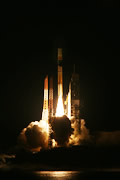 The H-IIA Launch Vehicle No. 18 (H-IIA F18) with the first quasi-zenith satellite "MICHIBIKI" onboard was launched at 8:17 p.m. on September 11 (Japan Standard Time) from the Tanegashima Space Center. The H-IIA F18 flew smoothly, and, at 28 minutes and 27 seconds after liftoff, the MICHIBIKI was separated from the H-IIA.
The H-IIA Launch Vehicle No. 18 (H-IIA F18) with the first quasi-zenith satellite "MICHIBIKI" onboard was launched at 8:17 p.m. on September 11 (Japan Standard Time) from the Tanegashima Space Center. The H-IIA F18 flew smoothly, and, at 28 minutes and 27 seconds after liftoff, the MICHIBIKI was separated from the H-IIA.
We will update you with the latest information on the MICHIBIKI on the special site.
(Photo: JAXA/Mitsubishi Heavy Industries)
September 6, 2010 Updated
MICHIBIKI live launch report from 7:45 p.m. on Sept. 11th (Sat.)
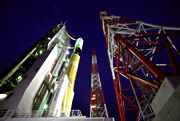 JAXA is broadcasting a live report of the H-IIA Launch Vehicle No. 18 launch with the first quasi-zenith satellite MICHIBIKI onboard from 7:45 p.m. on September 11 (Saturday,) 2010 (Japan Standard Time.)
JAXA is broadcasting a live report of the H-IIA Launch Vehicle No. 18 launch with the first quasi-zenith satellite MICHIBIKI onboard from 7:45 p.m. on September 11 (Saturday,) 2010 (Japan Standard Time.)
You can watch the report through the Internet and some cell phone services as well as at some JAXA offices, including JAXA i, Tsukuba Space Center, at scientific museums, and street vision locations. Please support the MICHIBIKI launch by watching the dynamic live launch images from the Tanegashima Space Center.
We welcome your support messages to the MICHIBIKI, as the project team awaits its launch. Some of the messages may be introduced during the live launch report.
* Please be aware that the launch live report schedule is subject to change due to the preparation status and weather conditions.
August 2010
August 20, 2010 Updated
The second issue of JAXA's English magazine "JAXA TODAY" published
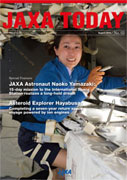 JAXA issued the second "JAXA TODAY," which is an English magazine to dispatch our latest information and activities to foreign countries.
JAXA issued the second "JAXA TODAY," which is an English magazine to dispatch our latest information and activities to foreign countries.
In the second edition, we feature Astronaut Naoko Yamazaki, who went to space on the Space Shuttle "Discovery," as well as the Venus climate orbiter "AKATSUKI" and the small solar power sail demonstrator "IKAROS," which were launched in May, and the asteroid explorer "HAYABUSA," which came back to the Earth in June. You can download the magazine from the JAXA website. Please keep an eye on JAXA Today!
August 4, 2010 Updated
MICHIBIKI new launch date decided!
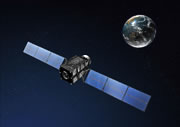 The new launch date of the First Quasi-Zenith Satellite "MICHIBIKI" by the H-IIA Launch Vehicle No. 18 has been set for September 11 (Sat.) The launch time will be between 8:17 and 9:16 p.m.
The new launch date of the First Quasi-Zenith Satellite "MICHIBIKI" by the H-IIA Launch Vehicle No. 18 has been set for September 11 (Sat.) The launch time will be between 8:17 and 9:16 p.m.
The launch of the MICHIBIKI was postponed due to a potential concern in the onboard reaction wheels, but the said part was replaced, thus we are ready for the launch.
We welcome your support messages to the MICHIBIKI at its special site. The project team who develops and operates the MICHIBIKI is looking forward to hearing from you.
August 2, 2010 Updated
HAYABUSA exhibition at Tsukuba Space Center till Aug. 6
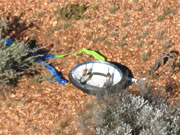 Following the exhibition at the Sagamihara City Museum, parts of the HAYABUSA's recovered capsule will be on display at the Tsukuba Space Center (TKSC) for a special exhibition between the 2nd (Mon.) through the 6th (Fri.) Also, the new exhibition hall has just opened at the TKSC. Please take this opportunity to visit the TKSC.
Following the exhibition at the Sagamihara City Museum, parts of the HAYABUSA's recovered capsule will be on display at the Tsukuba Space Center (TKSC) for a special exhibition between the 2nd (Mon.) through the 6th (Fri.) Also, the new exhibition hall has just opened at the TKSC. Please take this opportunity to visit the TKSC.
The TKSC does not have many parking space; moreover, the near-by roads are expected to be crowded during this exhibition period. Please use public transportations including the Tsukuba Express train. Your cooperation will be very much appreciated. If more people than the capacity of the exhibition hall come, you may have to wait outside. Please prepare for the recent hot weather conditions, such as taking a hat and drinks.
The JAXA information center, JAXA i, at Tokyo Marunouchi OAZO building, will also hold a special exhibition including the HAYABUSA capsule exhibition from the 15th (Sun.) through the 19th (Thu.)
July 2010
July 23, 2010 Updated
'Let's discover the mystery of space!'
Sagamihara Campus special open-house on July 30 and 31
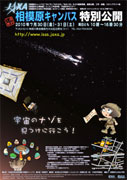 This annual summer open-house event will be held at the Sagamihara Campus for two days on July 30 (Fri.) and 31 (Sat.)
This annual summer open-house event will be held at the Sagamihara Campus for two days on July 30 (Fri.) and 31 (Sat.)
Thanks to cooperation from Kyowa Elementary School of Sagamihara City and Sagamihara City Museum, we will introduce the latest information on "KAGUYA," "HAYABUSA" and "AKATSUKI," and hold other interesting events including a plastic rocket class, a "mini-mini" space school, and a space science seminar. The HAYABUSA capsule, which was delivered to Earth by the HAYABUSA will be exhibited at the Sagamihara City Museum.
On August 2 (Mon.) through 6 (Fri.,) the capsule will be exhibited at the newly opened exhibition hall at the Tsukuba Space Center (TKSC.) The entrance fee is free, and no reservation is required. As it is one of the rare opportunities to have a look at the capsule, please also visit the TKSC exhibition hall.
It is expected to be very hot on the open-house days, thus please be ready for the heat.
July 13, 2010 Updated
Full of events for summer vacation! HAYABUSA capsule may be in your area!
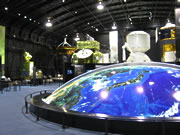 JAXA plans to have a lot of events this summer. The 17th (Sat.) is the grand opening day of the new Tsukuba Space Center exhibition hall. You can enjoy the reality and scale of virtual life-size test models of the HTV and satellites there.
JAXA plans to have a lot of events this summer. The 17th (Sat.) is the grand opening day of the new Tsukuba Space Center exhibition hall. You can enjoy the reality and scale of virtual life-size test models of the HTV and satellites there.
On the 30th (Fri.) and 31st (Sat.,) we will hold an annual summer vacation "open campus" event at the Sagamihara Campus. In August, the "JAXA i Kids Day" will wait for your visit.
This year's specialty is, of course, the HAYABUSA capsule. The capsule will be exhibited at the Sagamihara Campus, Tsukuba Space Center, and JAXA i, the information center of JAXA, in turn. Why don’t you come and take a look at the capsule that came back to Earth after a seven-year journey in space.
July 9, 2010 Updated
IKAROS: Acceleration by solar sail confirmed
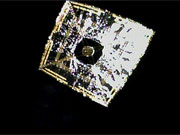 The small solar power sail demonstrator "IKAROS," which successfully deployed its solar sail, was confirmed to accelerate by solar sail receiving solar pressure.
The small solar power sail demonstrator "IKAROS," which successfully deployed its solar sail, was confirmed to accelerate by solar sail receiving solar pressure.
This proved that the IKAROS has generated the biggest acceleration through photon during interplanetary flight in history.
July 6, 2010 Updated
AKATSUKI successfully controls orbit by the world's first ceramic thruster
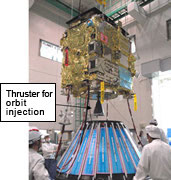 On June 28 (Japan Standard Time,) the Venus Climate Orbiter "AKATSUKI" successfully jetted the thrust of 500 Newton by its orbital maneuvering engine (OME) at a distance of 14.6 million km from the Earth or 1.06 Astronomical Units (AU) from the sun. The OME was a newly developed ceramic thruster made of silicon nitride (Si3N4.) It is the first time in the world to successfully generate the thrust by the ceramic thruster in space.
On June 28 (Japan Standard Time,) the Venus Climate Orbiter "AKATSUKI" successfully jetted the thrust of 500 Newton by its orbital maneuvering engine (OME) at a distance of 14.6 million km from the Earth or 1.06 Astronomical Units (AU) from the sun. The OME was a newly developed ceramic thruster made of silicon nitride (Si3N4.) It is the first time in the world to successfully generate the thrust by the ceramic thruster in space.
This engine is mainly used for retrofiring when the orbiter enters the Venus orbit, and the verification this time enabled us to confirm that the orbit control was carried out as scheduled.
The next orbit control is scheduled to be in early November, and the orbiter will be at the closest point to Venus and injected into the Venus orbit on December 7 (JST.)
July 5, 2010 Updated
Small particles found in the sample container of the HAYABUSA
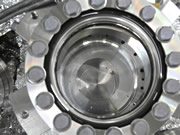 Minute particles were confirmed in the sample container of the HAYABUSA, whose unpacking operation was started on June 24 (JST) at the Curation Center at the Sagamihara Campus.
Minute particles were confirmed in the sample container of the HAYABUSA, whose unpacking operation was started on June 24 (JST) at the Curation Center at the Sagamihara Campus.
We are still unsure if those particles are something from the ITOKAWA or from the Earth, thus we will further examine them. (Image: opened sample container)
June 2010
June 24, 2010 Updated
Starting to open HAYABUSA sample container
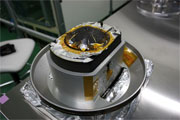 A capsule of the Asteroid Explorer "HAYABUSA," which returned to Earth on June 13, was brought to the curation facility at the Sagamihara Campus to be inspected and disassembled.
A capsule of the Asteroid Explorer "HAYABUSA," which returned to Earth on June 13, was brought to the curation facility at the Sagamihara Campus to be inspected and disassembled.
From the 24th, we finally started to open the sample container in the capsule. It will take one week to complete the opening of the container.
June 16, 2010 Updated
Successful image shooting of solar sail by IKAROS separation camera
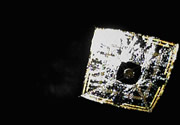 The small solar power sail demonstrator "IKAROS," which expanded its solar sail on June 10, released its separation camera and took images of the deployed solar sail successfully.
The small solar power sail demonstrator "IKAROS," which expanded its solar sail on June 10, released its separation camera and took images of the deployed solar sail successfully.
We will continue to measure the power generation status of the thin film solar cells attached to the sail, and will verify acceleration by the cells and orbit control by their acceleration.
June 14, 2010 Updated
Welcome back HAYABUSA to Earth after overcoming various difficulties!
 The Asteroid Explorer "HAYABUSA" successfully separated its capsule at 7:51 p.m. on June 13 (Japan Standard Time, the following times and dates are all JST,) and re-entered the atmosphere to complete its mission operation at 10:51 p.m.
The Asteroid Explorer "HAYABUSA" successfully separated its capsule at 7:51 p.m. on June 13 (Japan Standard Time, the following times and dates are all JST,) and re-entered the atmosphere to complete its mission operation at 10:51 p.m.
After the landing, a helicopter searched for the capsule in the Woomera Prohibited Area, and at around 11:56 p.m. on the 13th, its location was confirmed.
For about seven years since its launch by an M-V Launch Vehicle in May 2003, the HAYABUSA successfully completed a great achievement by landing on the asteroid "ITOKAWA," gathering rocks there, and returning to the Earth with them while overcoming various troubles.
June 11, 2010 Updated
IKAROS successfully deploys sail!
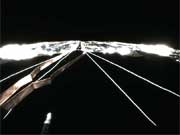 The Small Solar Power Sail Demonstrator "IKAROS" launched by the H-IIA F17 began to deploy its sail on June 3 (Japan Standard Time, JST,) and on June 10 (JST,) JAXA confirmed the proper extension of the sail and power generation by the thin film solar cells at about 7.7 million km from the Earth.
The Small Solar Power Sail Demonstrator "IKAROS" launched by the H-IIA F17 began to deploy its sail on June 3 (Japan Standard Time, JST,) and on June 10 (JST,) JAXA confirmed the proper extension of the sail and power generation by the thin film solar cells at about 7.7 million km from the Earth.
We will continue to measure the power generation status of the cells attached to the sail, and will verify acceleration by the cells and orbit control by their acceleration.
June 9, 2010 Updated
Launch day of MICHIBIKI decided! Special site opens
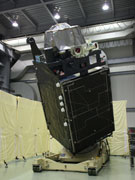 The launch day of the H-IIA Launch Vehicle No. 18 with the first Quasi-Zenith Satellite "MICHIBIKI" onboard was set between 10:54 p.m. and 11:54 p.m. on August 2 (Mon., Japan Standard Time.)
The launch day of the H-IIA Launch Vehicle No. 18 with the first Quasi-Zenith Satellite "MICHIBIKI" onboard was set between 10:54 p.m. and 11:54 p.m. on August 2 (Mon., Japan Standard Time.)
We have opened the "MICHIBIKI special site" to provide updated information about MICHIBIKI's preparation and launch status. Please enjoy the site.
We are welcoming your support messages at the special site. We are looking forward to delivering your messages to the MICHIBIKI project team who are in charge of development and operation of the satellite.
June 8, 2010 Updated
Let's welcome back HAYABUSA to Earth!
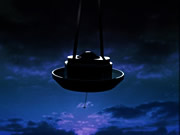 JAXA will broadcast a live report of the arrival of the Asteroid Explorer "HAYABUSA" on June 13th (Sun.) when it is scheduled to come back to Earth. The live broadcast is divided into two segments, from 12:45 p.m. and 7:30 p.m.
JAXA will broadcast a live report of the arrival of the Asteroid Explorer "HAYABUSA" on June 13th (Sun.) when it is scheduled to come back to Earth. The live broadcast is divided into two segments, from 12:45 p.m. and 7:30 p.m.
The report will show you not only the HAYABUSA's return trip but also scenes in the control room and people’s feelings toward the HAYABUSA mission. Let’s welcome the HAYABUSA back together!
We will hold a special open-facility at the Sagamihara Campus, where HAYABUSA operations are being performed, to provide a public viewing. Please look forward to the HAYABUSA’s return.
June 5, 2010 Updated
HAYABUSA heading to Australia
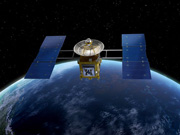 JAXA confirmed that the third trajectory correction maneuver (TCM-3) was successfully carried out for the Asteroid Explorer "HAYABUSA" at 1:44 p.m. on June 5 (Japan Standard Time.)
JAXA confirmed that the third trajectory correction maneuver (TCM-3) was successfully carried out for the Asteroid Explorer "HAYABUSA" at 1:44 p.m. on June 5 (Japan Standard Time.)
This operation completed the guidance of the HAYABUSA from the Earth's outer rim to the Woomera Prohibited Area in Australia.
June 2, 2010 Updated
Welcome home Astronaut Noguchi after five and half months in space!
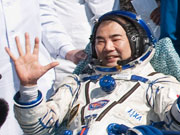 Astronaut Souichi Noguchi, who has lived on the International Space Station (ISS) since December 23, 2009, left the ISS at 9:04 a.m. on June 2 (Japan Standard Time) aboard a Soyuz spacecraft (21S/TMA-17). He successfully arrived back on Earth at 12:24 (JST) in the Republic of Kazakhstan. (Photo by JAXA/NASA/Bill Ingalls)
Astronaut Souichi Noguchi, who has lived on the International Space Station (ISS) since December 23, 2009, left the ISS at 9:04 a.m. on June 2 (Japan Standard Time) aboard a Soyuz spacecraft (21S/TMA-17). He successfully arrived back on Earth at 12:24 (JST) in the Republic of Kazakhstan. (Photo by JAXA/NASA/Bill Ingalls)
May 2010
May 26, 2010 Updated
Live broadcast of Astronaut Noguchi's return to Earth from 11:10 a.m.
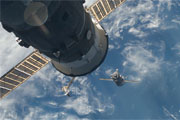 Astronaut Souichi Noguchi, who has been on an expedition to the International Space Station (ISS) for over five months, will come home on June 2 by the Soyuz (21S) spacecraft.
Astronaut Souichi Noguchi, who has been on an expedition to the International Space Station (ISS) for over five months, will come home on June 2 by the Soyuz (21S) spacecraft.
JAXA will broadcast his return trip live through the Internet as well as at our information center, JAXA i, from 11:10 a.m. on June 2. Please watch his return trip. (Photo by NASA)
* We are continuing to accept support messages to Astronaut Noguchi.
* Please be aware that the date and time of the live report are subject to change due to the preparation status of the mission and other factors.
May 23, 2010 Updated
AKATSUKI/IKAROS flying smoothly!
 On May 21, JAXA confirmed that the Venus Climate Orbiter "AKATSUKI,"
On May 21, JAXA confirmed that the Venus Climate Orbiter "AKATSUKI,"
launched by the H-IIA F17, successfully performed a sequence of scheduled operations such as the deployment of the solar array paddles and sun acquisition.
We have also received earth images taken by the AKATSUKI while verifying the condition of onboard devices at about 250,000 km above the Earth at around 8:50 p.m. on May 21.
The Small Solar Power Sail Demonstrator "IKAROS," which was also launched by the H-IIA F17 with the AKATSUKI, was also confirmed to have successfully generated power through the solar batteries and stabilized its correct posture. Accordingly, communications were established with the IKAROS.
May 21, 2010 Updated
AKATSUKI successfully launched!!
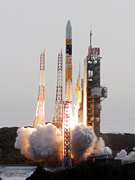 The H-IIA Launch Vehicle No. 17 (H-IIA F17) with the Venus Climate Orbiter "AKATSUKI" onboard was launched at 6:58:22 a.m. on May 21 (Japan Standard Time) from the Tanegashima Space Center. The H-IIA F17 flew smoothly, and, at 27 minutes and 29 seconds after liftoff, the AKATSUKI was separated from the H-IIA.
The H-IIA Launch Vehicle No. 17 (H-IIA F17) with the Venus Climate Orbiter "AKATSUKI" onboard was launched at 6:58:22 a.m. on May 21 (Japan Standard Time) from the Tanegashima Space Center. The H-IIA F17 flew smoothly, and, at 27 minutes and 29 seconds after liftoff, the AKATSUKI was separated from the H-IIA.
We will update you with the latest information on the AKATSUKI on the special site.
(Photo: Mitsubishi Heavy Industries)
May 18, 2010 Updated
AKATSUKI/IKAROS Launch rescheduled to 6:58 a.m. on the 21st (Fri)
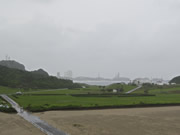 The launch of the Venus Climate Orbiter "AKATSUKI" and the Small Solar Power Demonstrator "IKAROS" by the H-IIA Launch Vehicle No. 17 was rescheduled at 6:58:22 a.m. on May 21 (Fri. Japan Standard Time, JST) after carefully studying the weather conditions.
The launch of the Venus Climate Orbiter "AKATSUKI" and the Small Solar Power Demonstrator "IKAROS" by the H-IIA Launch Vehicle No. 17 was rescheduled at 6:58:22 a.m. on May 21 (Fri. Japan Standard Time, JST) after carefully studying the weather conditions.
Accordingly, the live launch report will begin at 6:30 a.m. on May 21(Fri., JST.) The report will be broadcast not only through the Internet, but also at JAXA i, Sagamihara Campus and other public viewing locations including some universities. You can also watch it through some CATV and cell phone providers.
May 18, 2010 Updated
AKATSUKI/IKAROS launch postponement
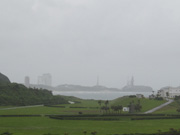 H-IIA Launch Vehicle No.17 with the Venus Climate Orbiter "AKATSUKI" and "IKAROS" onboard was scheduled to be launched on the 18th, but due to clouds including a freezing layer exceeding launch restrictions for weather around the launch site, the launch was postponed.
H-IIA Launch Vehicle No.17 with the Venus Climate Orbiter "AKATSUKI" and "IKAROS" onboard was scheduled to be launched on the 18th, but due to clouds including a freezing layer exceeding launch restrictions for weather around the launch site, the launch was postponed.
The new launch day will be announced as soon as it is determined.
May 11, 2010 Updated
Live launch report of AKATSUKI and IKAROS from 6:15 a.m. on the 18th
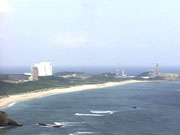 On May 18, the Venus Climate Orbiter "AKATSUKI" and the Small Solar Power Sail Demonstrator "IKAROS" will be launched by the H-IIA Launch Vehicle No. 17. The two payloads are now under final preparations at the Vehicle Assembly Building (VAB).
On May 18, the Venus Climate Orbiter "AKATSUKI" and the Small Solar Power Sail Demonstrator "IKAROS" will be launched by the H-IIA Launch Vehicle No. 17. The two payloads are now under final preparations at the Vehicle Assembly Building (VAB).
We will broadcast the live launch report through the Internet from the Tanegashima Space Center (TNSC). The live report will begin at 6:15 a.m. on the 18th (Tue.) We will also broadcast the live launch report at JAXA i, Sagamihara Campus and other public viewing sites including universities. Please enjoy the dynamic image of the launch from the TNSC and support the mission.
We also welcome support messages to the AKATSUKI and IKAROS project teams.
* The live report schedule is subject to change due to the launch preparation status and weather conditions.
April 2010
April 21, 2010 Updated
HAYABUSA's Sample Recovery Capsule to land on Earth on June 13
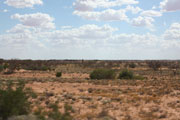 JAXA has been discussing with the Australian government the landing location for the Sample Recovery Capsule aboard the Asteroid Explorer "HAYABUSA," which is being carefully maneuvered for its return. As a result, we have received landing permission (the Authorized Return of Overseas Launch Space Object (AROLSO) from the Space Licensing and Safety Office (SLASO) of the Australian Government.
JAXA has been discussing with the Australian government the landing location for the Sample Recovery Capsule aboard the Asteroid Explorer "HAYABUSA," which is being carefully maneuvered for its return. As a result, we have received landing permission (the Authorized Return of Overseas Launch Space Object (AROLSO) from the Space Licensing and Safety Office (SLASO) of the Australian Government.
The HAYABUSA's capsule will enter the Earth's atmosphere at around 11:00 p.m. on June 13 (Japan Standard Time, or at 14:00 on the same day Universal Time, Coordinated) to land at the Woomera Prohibited Area in South Australia.
We will carry out a trajectory correction maneuver (TCM) for a few more times to make the landing as accurate as possible.
We have opened a special site for providing updated information about the HAYABUSA's trip home. In addition, the HAYABUSA project team Twitter has also started. We welcome your support messages to HAYABUSA and its project team. We are looking forward to hearing from you!
April 20, 2010 Updated
Discovery returns
Welcome home, Astronaut Naoko Yamazaki!
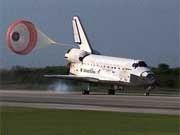 The Space Shuttle "Discovery", with Astronaut Naoko Yamazaki aboard, landed at the NASA Kennedy Space Center at 10:08 p.m. on April 20 (Japan Standard Time.) All tasks for the roughly 15-day mission, including the transportation of the Multi-Purpose Logistics Module, Leonardo, were successfully completed.
The Space Shuttle "Discovery", with Astronaut Naoko Yamazaki aboard, landed at the NASA Kennedy Space Center at 10:08 p.m. on April 20 (Japan Standard Time.) All tasks for the roughly 15-day mission, including the transportation of the Multi-Purpose Logistics Module, Leonardo, were successfully completed.
We were pleased to receive a lot of support messages. Thank you very much. We also are happy that many of you watched and enjoyed "SPACE@NAVI-Kibo." Thank you very much for supporting the mission. (Photo by NASA)
April 19, 2010 Updated
Astronaut Yamazaki to stay in space two additional days
Set to come home on April 20th (Tue.)
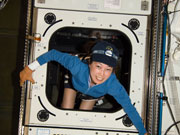 The Space Shuttle Discovery, which Astronaut Yamazaki is aboard, will stay one day longer in space than the original schedule, as its thermal protection system (TPS) will be checked while it is docked with the International Space Station (ISS), thus the work requires one extra day. Her flight to come home is rescheduled to arrive on Earth at 8:34 p.m. on April 20 (Tue, Japan Standard Time, or 7:34 a.m. on the same day U.S. Eastern Daylight-saving Time.)
The Space Shuttle Discovery, which Astronaut Yamazaki is aboard, will stay one day longer in space than the original schedule, as its thermal protection system (TPS) will be checked while it is docked with the International Space Station (ISS), thus the work requires one extra day. Her flight to come home is rescheduled to arrive on Earth at 8:34 p.m. on April 20 (Tue, Japan Standard Time, or 7:34 a.m. on the same day U.S. Eastern Daylight-saving Time.)
JAXA's Internet live broadcast of her arrival will start at 7:30 p.m. on April 20th (Tue.) at "SPACE@NAVI-Kibo SPECIAL LIVE." We will also broadcast it at JAXA i by extending the closing time. (Image by NASA)
* The arrival time has been rescheduled.
April 9, 2010 Updated
JAXA 2010 Spring Events for Science and Technology Week
 During the Science and Technology Week between April 12 and 18, JAXA will host some enjoyable events. Starting with "The 29th Space and Science Lecture and Movie" on the 10th, we will hold an open-house event at the Tsukuba Space Center (TKSC) on the 17th (Sat.), and at Chofu Aerospace Center (CAC) and Kakuda Space Center (KSPC) on the 18th (Sun.) We are preparing a lot of events that enable people to get close to aerospace, including a popular "plastic rocket bottle class" and "a lecture by Astronaut Furukawa" at the TKSC, and a "rocket darts game" at the CAC.
During the Science and Technology Week between April 12 and 18, JAXA will host some enjoyable events. Starting with "The 29th Space and Science Lecture and Movie" on the 10th, we will hold an open-house event at the Tsukuba Space Center (TKSC) on the 17th (Sat.), and at Chofu Aerospace Center (CAC) and Kakuda Space Center (KSPC) on the 18th (Sun.) We are preparing a lot of events that enable people to get close to aerospace, including a popular "plastic rocket bottle class" and "a lecture by Astronaut Furukawa" at the TKSC, and a "rocket darts game" at the CAC.
On the 25th (Sun.), the JAXA information center, JAXA i, will host "Spring Kids Day 2010." We plan to have games and hands-on learning events through which children can better understand "AKATSUKI" and "IKAROS" satellites, which will be launched soon. Please come and join us!
April 8, 2010 Updated
Astronaut Yamazaki moved Leonardo to the ISS
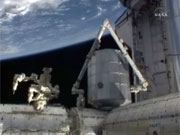 On the fourth day of the flight (April 8, JST) Astronaut Naoko Yamazaki manipulated the robotic arm (SSRMS) of the International Space Station (ISS) to take out the multi-purpose logistics module, Leonardo, from the cargo bay of the Space Shuttle Discovery. At 1:24 p.m. (JST), Leonardo was securely attached to the lower side (Earth side) of the Harmony (Node 2) of the ISS.
On the fourth day of the flight (April 8, JST) Astronaut Naoko Yamazaki manipulated the robotic arm (SSRMS) of the International Space Station (ISS) to take out the multi-purpose logistics module, Leonardo, from the cargo bay of the Space Shuttle Discovery. At 1:24 p.m. (JST), Leonardo was securely attached to the lower side (Earth side) of the Harmony (Node 2) of the ISS.
Leonardo is filled with lots of mission devices, experiment racks and supply cargo including a refrigerator and freezer (MELFI) which keeps test materials and chemicals at low temperatures for experiments carried out in Kibo, the Japanese Experiment Module. After moving all the cargo in Leonardo to the ISS, the logistic module will be taken back to the Discovery. (Photo by NASA)
April 7, 2010 Updated
Two Japanese astronauts in space for the first time!
Discovery docked with the ISS
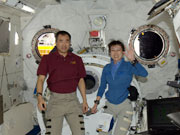 The Space Shuttle Discovery, with Astronaut Naoko Yamazaki aboard, docked with the International Space Station (ISS) at 4:44 p.m. on April 7 (Japan Standard Time.) At 6:11 p.m. on the same day (JST) the Discovery crew, including Astronaut Yamazaki, entered the ISS to get together with the ISS expedition crew including Astronaut Soichi Noguchi. This marks the first occasion that two Japanese astronauts are concurrently in space.
The Space Shuttle Discovery, with Astronaut Naoko Yamazaki aboard, docked with the International Space Station (ISS) at 4:44 p.m. on April 7 (Japan Standard Time.) At 6:11 p.m. on the same day (JST) the Discovery crew, including Astronaut Yamazaki, entered the ISS to get together with the ISS expedition crew including Astronaut Soichi Noguchi. This marks the first occasion that two Japanese astronauts are concurrently in space.
During her stay at the ISS, Astronaut Yamazaki will coordinate cargo transportation operations between the Shuttle and the ISS as a Load Master, and manipulate the robotic arms of the Shuttle and the ISS to move the multi-purpose logistics module, Leonardo.
Astronaut Yamazaki will stay in space until April 16th (Fri.) Discovery is scheduled to leave the ISS and return to Earth on April 18th (Sun.) (Photo by NASA)
April 5, 2010 Updated
Flying to the Future
Discovery with Astronaut Yamazaki aboard launched
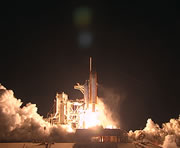 Space Shuttle Discovery with Astronaut Naoko Yamazaki aboard was launched at 7:21 p.m. on April 5 (Mon. Japan Standard Time, or 6:21 a.m. on the same day U.S. Easter Daylight Saving Time) from NASA Kennedy Space Center.
Space Shuttle Discovery with Astronaut Naoko Yamazaki aboard was launched at 7:21 p.m. on April 5 (Mon. Japan Standard Time, or 6:21 a.m. on the same day U.S. Easter Daylight Saving Time) from NASA Kennedy Space Center.
Discovery will be docked with the International Space Station (ISS,) where Astronaut Soichi Noguchi is staying. The two Japanese astronauts will meet in space.
On April 7th (Wed.,) SPACE@NAVI-Kibo SPECIAL LIVE will broadcast a live report of Discovery-ISS docking from 4:00 p.m., and Astronaut Yamazaki entering the ISS from 6:00 p.m. Don’t miss the broadcast!
We are welcoming support messages to Astronaut Yamazaki. (Photo by NASA)
March 2010
March 31, 2010 Updated
Live report of Astronaut Yamazaki's departure at 6:30 p.m. on April 5
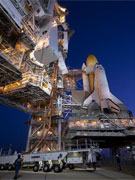 At 7:21 p.m. on April 5 (Mon, Japan Standard Time,) Space Shuttle Discovery, with Astronaut Naoko Yamazaki aboard, will be launched.
At 7:21 p.m. on April 5 (Mon, Japan Standard Time,) Space Shuttle Discovery, with Astronaut Naoko Yamazaki aboard, will be launched.
JAXA will broadcast the live launch report from 6:30 p.m. on April 5th through the Internet and some public viewing sites including JAXA i.
We are also welcoming support messages to Astronaut Yamazaki. Please support this mission in which two Japanese astronauts will be in space at the same time. (Photo by NASA)
* The date and time of the live broadcast are subject to change due to launch preparations and weather conditions.
March 27, 2010 Updated
Astronaut Naoko Yamazaki leaves for space at 7:21 p.m. on April 5 (Mon., JST)
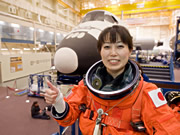 The Space Shuttle "Discovery," which Astronaut Naoko Yamazaki will be aboard (STS-131/19A mission,) is officially announced to be launched at 7:21 p.m. on April 5 (Mon.) Japan Standard Time (or at 6:21 a.m. on the same day U.S. Eastern Daylight Saving Time.)
The Space Shuttle "Discovery," which Astronaut Naoko Yamazaki will be aboard (STS-131/19A mission,) is officially announced to be launched at 7:21 p.m. on April 5 (Mon.) Japan Standard Time (or at 6:21 a.m. on the same day U.S. Eastern Daylight Saving Time.)
This is the first flight to space for Astronaut Yamazaki, and, as the first Japanese female mission specialist, she will mainly manipulate the robotic arm of the International Space Station (ISS) and Space Shuttle to move a Multi-Purpose Logistics Module, Leonardo, from the Space Shuttle to the ISS, then take it back to the Shuttle. She will also work as a Load Master to be responsible for overall material transportation operations between the Shuttle and the ISS.
Currently, Astronaut Soichi Noguchi is on the expedition mission at the ISS, thus Astronaut Yamazaki's trip to space will mark the first occasion for two Japanese astronauts to stay in space at the same time.
JAXA will broadcast the live Space Shuttle launch through the Internet and at JAXA i. We are also welcoming support messages to Astronaut Yamazaki.
(Photo by NASA)
March 16, 2010 Updated
Kibo's small fine robotic arm attached!
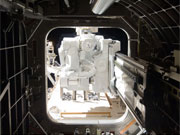 On March 10 and 11, Astronaut Soichi Noguchi and Astronaut Timothy J Creamer used the airlock of the Japanese Experiment Module "Kibo" Pressurized Module for the first time to take the Kibo's Small Fine robotic Arm (SFA) out of the International Space Station.
On March 10 and 11, Astronaut Soichi Noguchi and Astronaut Timothy J Creamer used the airlock of the Japanese Experiment Module "Kibo" Pressurized Module for the first time to take the Kibo's Small Fine robotic Arm (SFA) out of the International Space Station.
On March 12, Astronaut Noguchi and other astronauts manipulated the Kibo's robotic arm, and at 0:16 a.m. on March 13, the SFA was attached to the SFA Stowage Equipment, or SSE, on the Exposed Facility. With the SFA on the SSE, all of the Kibo's system devices were installed, and their functional checks were completed. Kibo's basic function has now been successfully established.
March 3, 2010 Updated
"AKATSUKI" launch date set! Special site open
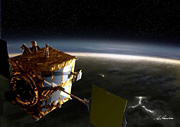 The launch time and day of the H-IIA Launch Vehicle No. 17 (H-IIA F17) has been set for 6:44:14 a.m. on May 18. The H-IIA will carry the Venus Climate Orbiter "AKATSUKI," the Small Solar Power Sail Demonstrator "IKAROS," and four other small satellites to space.
The launch time and day of the H-IIA Launch Vehicle No. 17 (H-IIA F17) has been set for 6:44:14 a.m. on May 18. The H-IIA will carry the Venus Climate Orbiter "AKATSUKI," the Small Solar Power Sail Demonstrator "IKAROS," and four other small satellites to space.
The AKATSUKI special website opens today to keep you updated about its preparation status before its arrival to the Venus orbit. Please enjoy the site.
February 2010
February 10, 2010 Updated
Thank you very much for participating in the AKATSUKI message campaign
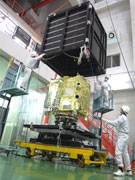 We have received many support messages from all over the world for the "AKATSUKI" message campaign, which was completed on January 10. The number of participants reached 260,214 people in total including those who registered through the Internet and those who signed up as a group from local areas, schools and science museums. We have also received messages from some celebrities. The messages will be printed on an aluminum plate, and attached to the body of the AKATSUKI. The satellite will then be transferred to the Tanegashima Space Center for launch preparations.
We have received many support messages from all over the world for the "AKATSUKI" message campaign, which was completed on January 10. The number of participants reached 260,214 people in total including those who registered through the Internet and those who signed up as a group from local areas, schools and science museums. We have also received messages from some celebrities. The messages will be printed on an aluminum plate, and attached to the body of the AKATSUKI. The satellite will then be transferred to the Tanegashima Space Center for launch preparations.
The "IKAROS x Lightsail" Support Campaign for the Small Solar Power Sail Demonstrator "IKAROS," a co-payload of the AKATSUKI, is continuing. Messages sent for this campaign will fly over the solar system with the IKAROS. Please also join this project!
January 2010
January 28, 2010 Updated
English magazine "JAXA TODAY" starts publication
 JAXA has started to issue an English magazine, "JAXA TODAY," to dispatch our latest information and activities overseas. We hope the magazine will further facilitate people’s understanding of our activities. It will convey JAXA's "TODAY," such as updated information of our space development, space science, and aviation technology research, as well as some behind-the-scene activities.
JAXA has started to issue an English magazine, "JAXA TODAY," to dispatch our latest information and activities overseas. We hope the magazine will further facilitate people’s understanding of our activities. It will convey JAXA's "TODAY," such as updated information of our space development, space science, and aviation technology research, as well as some behind-the-scene activities.
You can download the magazine from the JAXA website. We will periodically issue JAXA TODAY, so why don't you check our first issue now!
January 20, 2010 Updated
"MICHIBIKI" chosen as nickname for QZS-1
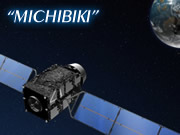 Some 11,111 people sent us various suggestions for the nickname campaign of the first Quasi-Zenith Satellite (QZS-1) scheduled to be launched in Japan Fiscal Year 2010, and among them, "MICHIBIKI" was selected.
Some 11,111 people sent us various suggestions for the nickname campaign of the first Quasi-Zenith Satellite (QZS-1) scheduled to be launched in Japan Fiscal Year 2010, and among them, "MICHIBIKI" was selected.
"MICHIBIKI"means "guiding" or "showing the way."
Many people who proposed "MICHIBIKI" explained their selection reason as the QZS-1 is to show us a correct location using its accurate positioning information, and to guide us toward a futuristic society by establishing the next generation satellite positioning technology in Japan. As the name precisely illustrates the QZS mission, this name was chosen.
We held a draw to select one person among all the godparents who recommended "MICHIBIKI" to invite him to the Tanegasima Space Center, and Mr. Hajimu Nishikawa (in his 50s, from Wakayama Prefecture) won the invitation.
January 14, 2010 Updated
HAYABUSA coming back to terrestrial gravitation realm! Soon to be home
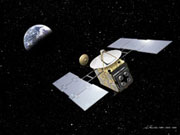 The Asteroid Explorer “HAYABUSA,” which is on its way back to the Earth, has gradually been changing its orbit to come closer to the Earth. The explorer is now confirmed to be on an orbit that passes through the inside of the terrestrial gravitation sphere (about 1.4 million km from the Earth.)
The Asteroid Explorer “HAYABUSA,” which is on its way back to the Earth, has gradually been changing its orbit to come closer to the Earth. The explorer is now confirmed to be on an orbit that passes through the inside of the terrestrial gravitation sphere (about 1.4 million km from the Earth.)
Currently, the HAYABUSA is flying about 60 million km away from the Earth. Its flight orbit is scheduled to be moved inside the moon orbit.
January 1, 2010 Updated
First Japanese astronaut greets the New Year from space
"A Happy New Year!" from Astronaut Noguchi stationed at the ISS
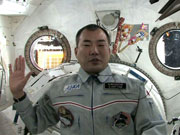 We have received a New Year’s message from Astronaut Soichi Noguchi, who has been residing at the International Space Station (ISS) since December 23, 2009.
We have received a New Year’s message from Astronaut Soichi Noguchi, who has been residing at the International Space Station (ISS) since December 23, 2009.
Astronaut Noguchi is the first Japanese national who started the New Year in space.
We welcome your support messages to Astronaut Noguchi, who is in the midst of a mission.